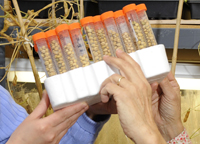AMES, Iowa - A newly discovered gene introduced into soybean plants has increased the amount of protein in the plant's seed and could hold promise for helping meet nutritional needs of a hungry world.
Eve Wurtele, professor of genetics, development and cell biology; and Ling Li, an adjunct assistant professor and an associate scientist working in her laboratory, have placed a gene found only in Arabidopsis plants into soybean plants and increased the amount of protein in the soybean seeds by 30 to 60 percent.
The results were a pleasant surprise to the researchers as the function of the gene, known as QQS, in the Arabidopsis was previously unclear because its sequence is very dissimilar from all other plant genes.
Arabidopsis is a small, flowering plant in the mustard family that is often used in scientific research.
"Most genes contain clues in their DNA sequence as to their biological function," said Wurtele. "But this one has no sequence features that gave us any hint of what it's doing."
 Soybean seeds
with the gene contain 30 to 60 percent more protein.
Soybean seeds
with the gene contain 30 to 60 percent more protein.
When the researchers neutralized the gene in Arabidopsis, they discovered the gene was involved in regulating starch accumulation, called deposition.
"Based on the changes in activities of other genes that occurred when we altered QQS, we conjectured that it wasn't directly involved in starch synthesis, but rather it may be involved in altering [the plant's] composition in general," said Wurtele. "We decided to test this concept by transferring the gene to an agronomically important plant species, soybean, which has a seed and is important as a source of vegetable protein and oil."
"We found that the QQS transgene increased protein production in the soybean seed," she added. "That was the best possible scenario."
In addition to having a DNA sequence that is not similar to any other gene in that or any other plant, the gene is also unusual because it has only 59 amino acids, Li said. The median size of a gene in Arabidopsis plants is 346 amino acids.
Li discovered the gene in 2004 and named it for her daughter.
"My daughter was a half-year old. This gene was so small and my daughter was so small," Li laughs. "QQ is my daughter's nickname in Chinese."
In addition to altering the protein-producing qualities of the gene, Wurtele hopes that the discovery may lead to greater understanding of other genes that don't have recognizable functionalities based on their sequences.
"This may give us an insight into the other genes with obscure features and provide us a window as to how they function," she said.
Wurtele hopes the discovery may help people in areas who survive on protein-deficient diets.
"We were so pleased [the gene] altered composition in soybean," she said. "What if this basic research discovery could lead to increased protein content in potatoes, cassava, or other crop species that are staples to people in developing nations?
"That would be better than I imagined."
This research is supported in part by funding from the National Science Foundation and Iowa State University's Plant Science Institute.
This patent-pending technology is available for licensing from
the Iowa State
University Research Foundation, which also provided
technology development funds.